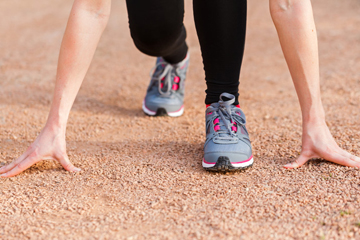
The causes of runner’s knee don’t actually have much to do with the knee; it occurs due to muscle imbalances around areas such as hips, glutes, IT bands and quads. Simple strengthening exercises, especially lower-body exercises that target hip areas, can help prevent runner’s knee before it strikes.
- Fire Hydrant: This is a hip strengthening exercise that targets the quads, thighs, and glutes at the same time. Get down and support your weight with your knees and hands on the floor. Lift your right knee to the side and keep it flexed at 90 degrees before returning to the original position, then do the same with your left. Repeat 15 times.
- Clamshells: Lye on your right side with your knees bent on top of each other and your right arm under your head to support it. Keeping your feet together, open the clamshell by lifting your top knee up. While your hips will rotate during this exercise, your pelvis and core should remain stable. Close the clamshell, repeat 15 times and switch sides.
- Wall Sit: Stand with your back against a wall with feet shoulder-width apart, two to three from the wall. Slowly slide your back against the wall, using your hands on the wall for balance, until your legs are bent at a 90-degree angle or in a chair-like position and thighs parallel to the ground. Make sure your back is against the wall with feet and legs parallel the entire time. Hold this pose for 30 to 60 seconds and then stand back up. Repeat this for three reps.
You can also make a wall sit a little more challenging by lifting your right heel for a few seconds and then your left heel. You can create even more of a challenge and resistance by adding weights. Do two to three sets. - IT Band Foam Rolling: This is a hip flexibility and mobility exercise. Foam rolling is a great way to alleviate knee pain and lower body tightness that can come from running long distances. Begin the exercise, while on your side; place your hip on the top of the foam roller just below the hip joint. Stack your legs, and use your hands to stabilize your body. Slowly roll down toward your knee, stopping before the roller reaches the knee and then roll back up. Repeat 5-10 times, and switch sides.
- Bird Dog: Begin on all fours with your hands directly under your shoulders and your knees directly under your hips. Extend your right arm out in front of your body and your left leg out behind your body. Hold for 2 seconds before bringing your right hand and left knee together under your body. Repeat the motion 10-15 times, and switch sides.
- Hip Flexor Stretch: This exercise mainly targets your glutes. Many people sit all day and their hip flexors become extremely short. This move opens the front of your hip for increased mobility. Start with left knee on the ground, right foot planted and leg bent at 90 degrees, hands on hips, drive your hips forward toward your right knee by squeezing your glutes. Slowly move forward and back 15 to 20 times. Switch legs and repeat.
- Rotation Stretch: This move improves the natural rotation in your hips, abdominals and back muscles. Start with your left knee on the ground, right leg bent at 90 degrees and raise left arm straight in front of you, right hand resting gently on hip. Squeeze your glutes and slowly rotate your upper body, until your left arm is pointing towards your right knee. Hold for a few seconds and return to start. Repeat 15 to 20 times, then switch legs and repeat on opposite side.
These simple exercises can prevent runner’s knee. However, if you have knee pain that persists for three weeks or longer and it affects your mobility, consult a doctor or physical therapist.